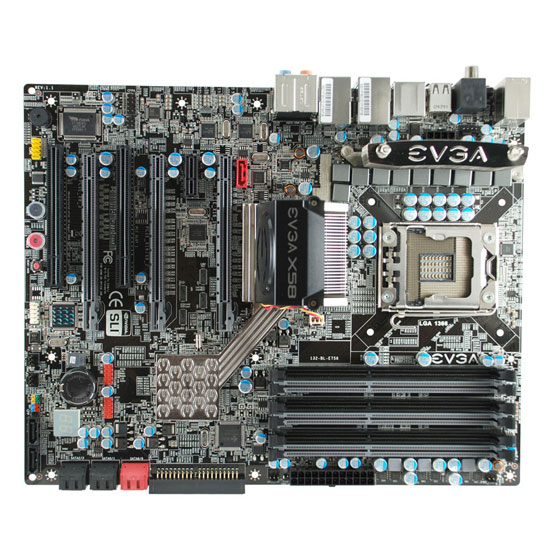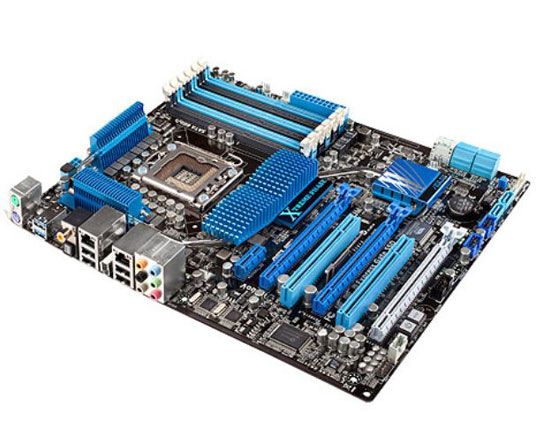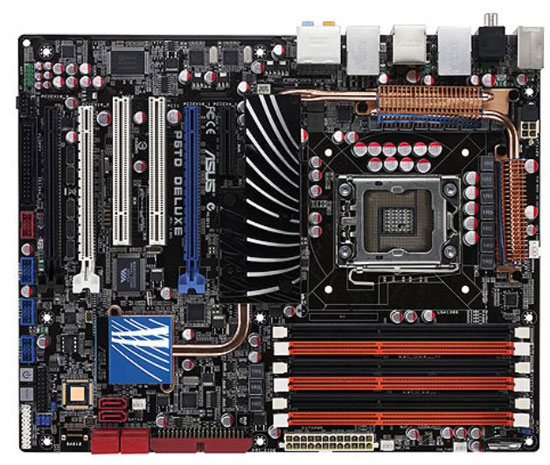Loyd's New Year - A Trio of Problem Systems
by Loyd Case on January 13, 2010 12:00 AM EST- Posted in
- Systems
The Slowly Dying Motherboard
My production system runs a Core i7 965 and 12GB of OCZ DDR3-1600 memory. The 965 clocks at 3.33GHz, and the memory runs at 1333MHz. In either case, it’s not really much of an overclock. The X58 chipset and Core i7 socket 1366 CPUs are rated at DDR3-1066 speeds officially. So technically, the memory is being overclocked.
The system was based on an eVGA X58 SLI motherboard – one of the early versions that shipped. I’d updated the BIOS as new versions came out.

Recently, I’d been having a weird series of glitches. My USB ports would stop working. Once every couple of days, I’d lose network connectivity. My audio would mysteriously stop working, even though I’d see audio activity in any media player, and the speakers seemed to be behaving correctly.
If finally occurred to me that maybe my I/O controller hub was slowly failing, or had developed an intermittent hiccup that created these seemingly unrelated issues.
So I decided to upgrade my motherboard.
My general philosophy when it comes to building the systems I actually use for productive work and personal gaming is to be somewhat conservative – if I can. Go with solutions that seem reliable and robust. I’d waited to upgrade my own system to Core i7 until I’d tested a slew of X58 boards, and the eVGA board had seemed stable. In fact, it had been running problem-free for months.
So naturally I ignored my own inclinations and bought a brand spanking new Asus P6X58D, which sported a discrete NEC USB 3.0 controller and a Marvell SATA 6gbps disc controller.

The board arrived, and seemed to install normally. Windows enumerated all the devices properly, and rebooted as expected. I installed the new drivers from the Asus DVD and rebooted.
Then a new symptom developed: after a warm boot, the fan on the Radeon HD 5870 would spin up to maximum speed and stay there. The sound was almost deafening. When this would occur, the system wouldn’t POST. Only shutting down the power supply and waiting a couple of minutes would allow for a normal boot.
Whiskey. Tango. Foxtrot.
After trying a variety of things – different CPUs, swapping in different memory, upgrading the BIOS (from 0201 to 0402) and even swapping in a different AMD graphics card, nothing changed. So I gave up. I headed out to my local friendly white box shop (Central Computer in San Jose), I picked up another Asus board: a P6TD Deluxe. The P6TD is a second (third?) generation X58 board from Asus, with more copper and 16-phase power. It’s really a souped up P6T board, but refined over the original design.

Swapped back in my original components, fired up the system and held my breath.
The system POSTed normally. Since then, I’ve run a number of applications, including some fairly system intensive games, and it’s all behaving as it should.
Lesson learned: when you need a working system for, well, work, then don’t go with the bleeding edge. I knew that already, but every now and then, I have to re-learn it. I suppose it’s my eternally optimistic nature, but I tend to believe that newer is often better. Alas, it’s not always the case.










109 Comments
View All Comments
loydcase - Wednesday, January 13, 2010 - link
For what it's worth, my daughter doesn't just play flash games. While Torchlight is not a big system hog, she also plays games like NeverWinter Nights 2, Titan Quest, Sins of a Solar Empire and other RTS and RPG titles.glockjs - Friday, January 15, 2010 - link
you just named a slew of games that a 9800pro could easily handle :pFinally - Wednesday, January 13, 2010 - link
[quote]shows the reality we go through[/quote]I'd rather state it this way:
This article shows the reality PC-incometent people have to go through, on a regular basis.
I'd say it's pretty hard to find a non-marketing-related article on the web that recommends going for that upgrade option, especially if you have a basement full of hi-end hardware and close to limitless software supplies at hand like the author here...
Mugur - Wednesday, January 13, 2010 - link
Hi,Just a quick comment regarding the first case: that machine needed just a clean Windows 7 installation (or even a clean Vista installation). No need to replace an "old" quad core with a "new" dual core...
And never do an upgrade XP - Vista or XP - 7, or even Vista - 7... Just clean installations.
masterbm - Wednesday, January 13, 2010 - link
The reminded me of my own experience of that. I have nforce 3 board that had suffered from various it seemed every 3 or 4 months and Then would be fine. Well last week it turned out that issue came from sata controller that was no longer function like it should. But I I did replace the core(ram,cpu,motherboard) of the machine anyway. It is time retire it.svrmstr - Wednesday, January 13, 2010 - link
Thanks for writing this article! I've experienced what you’re talking about with the first system.I have a P5Q3 Deluxe with 2 GB Corsair memory, a Q9550 and a Radeon 4870. I must say that this motherboard is extremely quirky when it comes to memory. I had to return 2 pairs of Corsair RAM before I got a set that would post - each pair that Newegg sent me was different, because they were being discontinued almost as quickly as they were released. Even after I got the system to POST with the 3rd set, I encountered lots of memory errors, but these errors weren't due to bad RAM chips, as I discovered using MemTest86+. I should mention that at the time, the RAM was on the QVL list, although that list has since gone through numerous revisions.
I spent a solid week researching and learning everything I could about the motherboard, quad-core CPUs and overclocking. (I wasn't trying to overclock at first, but such information would help me understand exactly what had to be done.) A few articles on AnandTech that dealt with Asus motherboards, overclocking and BIOS settings definitely pointed me in the right direction. Along with a couple of lengthy guides to overclocking with quad-core CPUs from other sources, I gained enough knowledge to make the system stable.
In the end, it involved fine-tuning the BIOS, setting just about every option manually. This meant many long hours of trial and error. As it turned out, the CPU settings required the most tweaking. Getting the right VCORE, PLL and GTL voltages, plus adding a 100ns delay really made a difference – the northbridge settings were also sensitive. It wasn’t a matter of faulty RAM, as was the symptom, rather instabilities with the system as a whole. Individually each part performed flawlessly, but put them and you create a monster time sink. Notably, when I swapped in a Core 2 Duo E8400, all the memory errors went away. That’s when I decided to really focus on the CPU settings. Honestly, this motherboard doesn’t have reliable automatic settings, especially when you’re using a Core 2 Quad. Let me add that I’ve used every BIOS revision since 1702 and they’ve all performed the same for me.
Now I’m running at 3.4 GHz core speed, 1600 MHz FSB and 1600 MHz memory. I wanted so badly to give up in favor of building a newer, better system, but it just wasn’t in my budget. I hope that my story isn’t too long; I wanted to share what I could. Here are links to some of the articles I read:
http://www.ocztechnologyforum.com/forum/showthread...">http://www.ocztechnologyforum.com/forum...354d2fa1...
http://www.ocztechnologyforum.com/forum/showthread...">http://www.ocztechnologyforum.com/forum/showthread...
http://www.ocztechnologyforum.com/forum/showthread...">http://www.ocztechnologyforum.com/forum...354d2fa1...
http://www.anandtech.com/mb/showdoc.aspx?i=3309&am...">http://www.anandtech.com/mb/showdoc.aspx?i=3309&am...
http://www.anandtech.com/mb/showdoc.aspx?i=3129&am...">http://www.anandtech.com/mb/showdoc.aspx?i=3129&am...
http://www.benchzone.com/page.php?al=Asus_P5Q3_Del...">http://www.benchzone.com/page.php?al=Asus_P5Q3_Del...
nicknomo - Wednesday, January 13, 2010 - link
I've had the same experience.. I've never really ran into memory that didn't work in a machine after some degree of tweaking in the BIOS.I think that is an important lesson to learn, and a much better solution then constantly RMA'ing parts.
Just by looking at the reviews in newegg, I can see that most RAM incompatability issues seems to happen with modules that require higher voltages. With the advent of O/C'ing, a lot of manufacturers make memory that will only boot .2 or .3 volts above what a normal DIMM operates at.
Other problems usually stem from the motherboard reading the SPD of the modules and incorrectly setting the timings. Either way, bumping up the voltage on the memory and setting the timings and clock speed manually will often fix 99% of these problems..
yyrkoon - Thursday, January 14, 2010 - link
I have. That is, whenever I get CRC errors, or corrupt files, the first thing I do is check the BIOS settings for the memory to make sure they're correct. When I build a system the first thing I do after the first POST is to check to make sure these settings are correct. timings, as well as voltage.I have however had bad sticks of memory from certain manufactures that I now try to avoid like the plague. They have good parts too, but I would rather not play a guessing game when trying to set up a new system.
Even my own favored brand rarely seems to relay the proper information to many a motherboard, so perhaps this is where / why I picked up this habit.
yonzie - Wednesday, January 13, 2010 - link
A few years ago I had a pair of MSI 945G mATX boards heading for a server.The harddrive I planned to use for one of the servers consistently killed the board.
It worked fine in other boards, the MSI board worked fine with other drives.
The combination of this particular drive and motherboard model consistently killed the board dead. Not helping troubleshooting, it worked fine on the initial boot, then it was gone.
biostud - Wednesday, January 13, 2010 - link
One of my friends had the same problem with the i7 and corsair memory, to get the system stable the memory had to run 1066Mhz, otherwise it would crash at random.